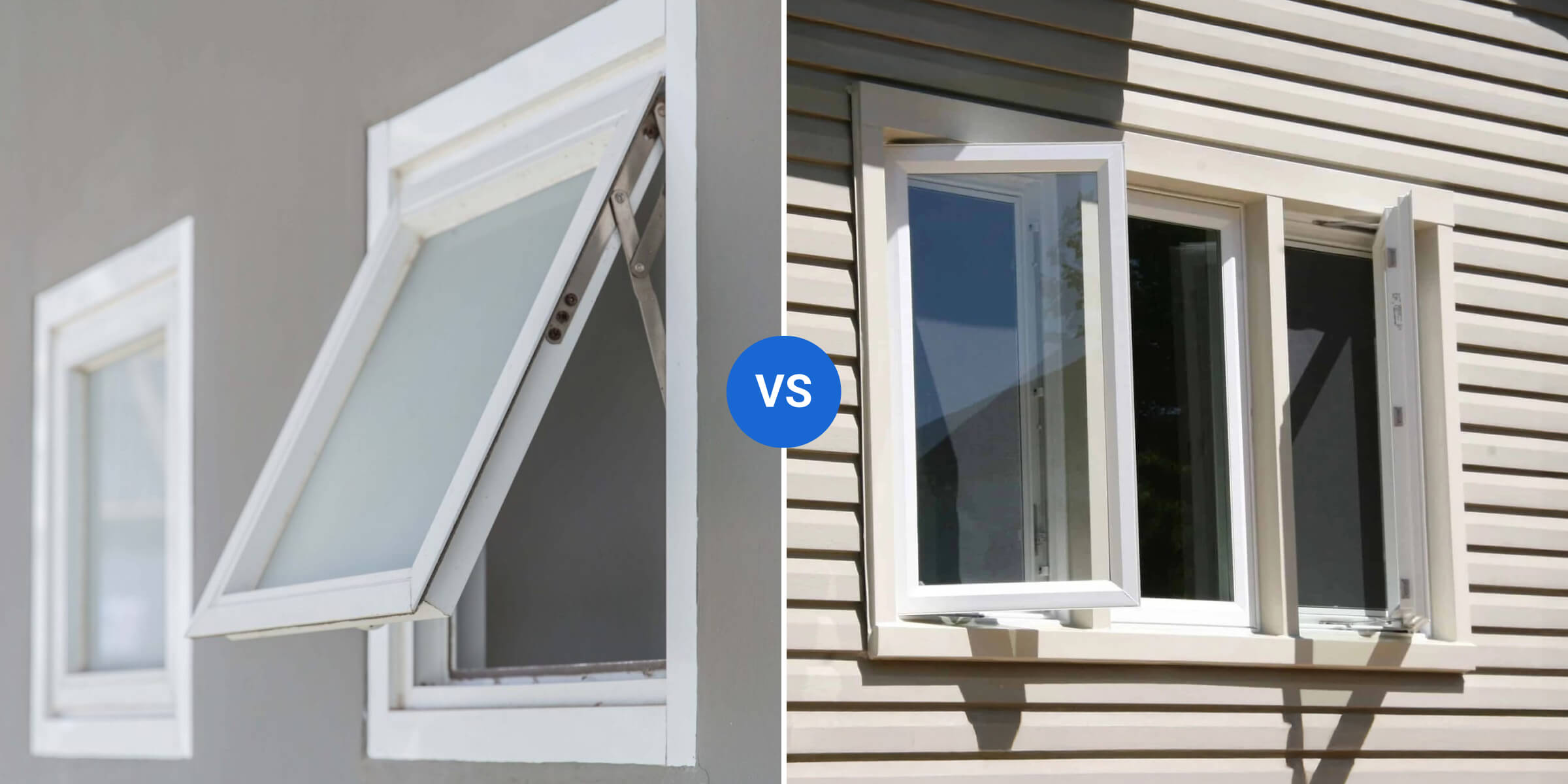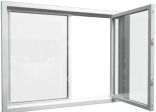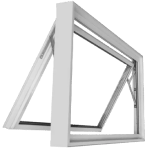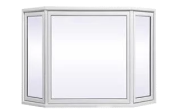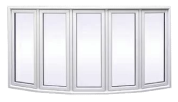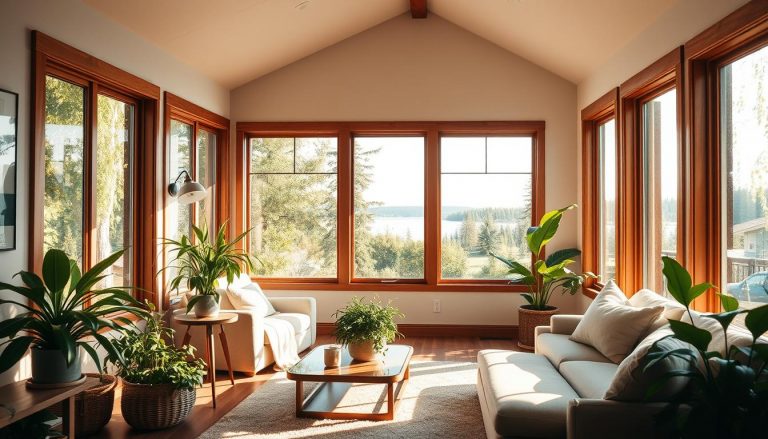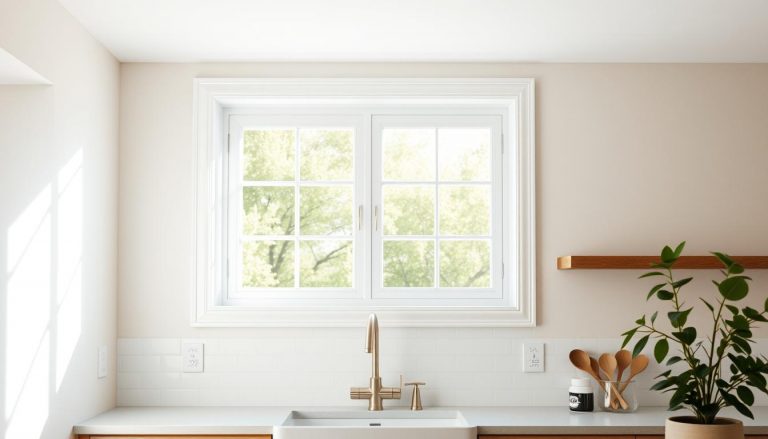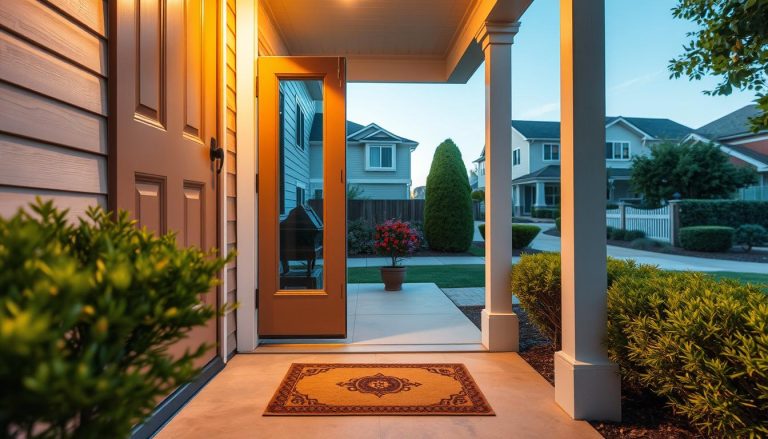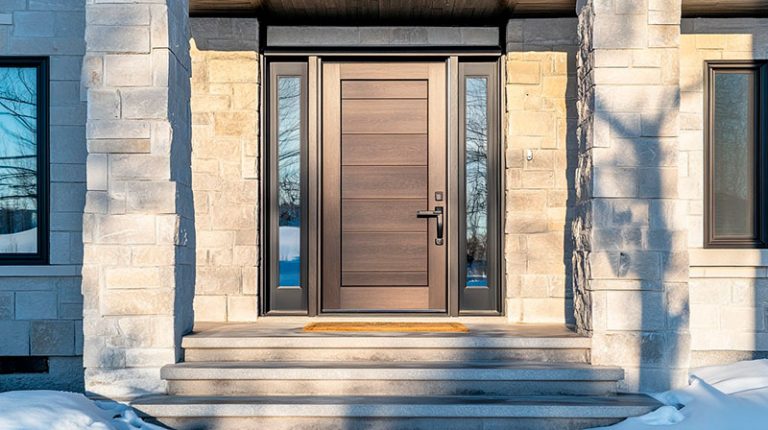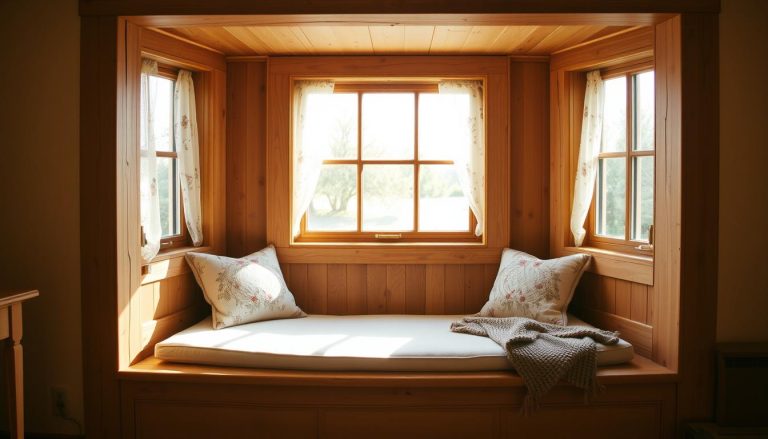Did you know choosing the right energy-efficient windows can slash your energy bills by up to 15%? As a Sales Consultant at Total Home Windows and Doors, I’ve seen firsthand how the great debate of awning vs casement windows has Canadian homeowners buzzing about aesthetics and efficiency. Let’s open up the conversation and explore these two popular window styles to help you make an informed choice for your home.
Window Replacement Near Me
Awning Windows VS Casement Windows
Your Top-Hinged Marvels
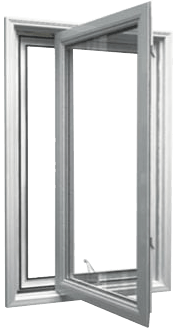
The awning window hinged at the top and opening outward from the bottom, offers a unique blend of style and functionality. This versatile window is an excellent choice for many Canadian homes, particularly where you want ventilation without compromising privacy.
Description
Awning windows are characterized by their top-hinged design, allowing them to open outward from the bottom. This unique configuration makes them ideal for bringing fresh air into your home while keeping the rain out. They’re often used in combination with other window styles or installed higher up on walls to maximize natural light and ventilation. Professional expertise in installing windows is crucial to ensure optimal performance and longevity of awning windows.
The Side-Swinging Sensation
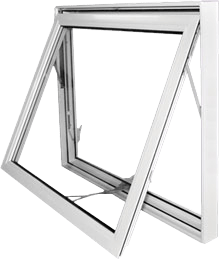
Casement windows hinged on one side and opening outward like a door, provide a classic look with modern benefits. These windows are a popular choice for Canadian homeowners looking for maximum ventilation and unobstructed views.
Find related services
Description
Casement windows are side-hinged windows that open outward, much like a door. They’re operated using a crank mechanism, which allows for easy opening and closing. When fully open, casement windows provide excellent ventilation and offer unobstructed views of the outdoors. Casement windows are among the most energy-efficient windows available.
Pros of Awning Windows
Pros of Casement Windows
Cons of Awning Windows
Cons of Casement Windows
Find related products
A Clear View: Side-by-Side Comparison
To help you make an informed decision, let’s compare awning and casement windows side by side:
| Feature | Awning Windows | Casement Windows |
| Hinge Location | Top | Side |
| Opening Direction | Outward from bottom | Outward from side |
| Ventilation | Good | Excellent |
| Energy Efficiency | High | Very High |
| View Obstruction | Minimal | None when open |
| Operability | Crank | Crank |
| Rain Protection | Excellent | Good |
| Security | Good | Excellent |
| Maintenance | Low | Low to Moderate |
Similarities: The Common Ground
Despite their differences, awning and casement windows share several key features:
- Crank Mechanisms: Both window styles utilize crank mechanisms for easy operation, making them ideal for hard-to-reach places.
- Energy Efficiency: Awning and casement windows both offer excellent energy efficiency due to their airtight seals when closed.
- Versatility: These windows are suitable for various room types and wall spaces, adapting well to different architectural styles.
- Material Options: Both styles are available in multiple materials and finishes, including vinyl, wood, and fiberglass.
- Combination Potential: Awning and casement windows can be combined with fixed windows for unique designs and optimal functionality.
"The versatility of both awning and casement windows is what makes them so popular. They can be adapted to suit almost any home style or personal preference." -Eugene Siukayev, Project Manager
Differences: The Deciding Factors
While awnings and casement windows share many similarities, several key differences might influence your decision:
| Feature | Awning Windows | Casement Windows |
| Opening Direction and Range of Motion | Open from the bottom with limited range of motion | Open from the side and can open fully |
| Suitability for Different Wall Spaces | Ideal for wider, shorter spaces or high on walls | Work well in taller, narrower spaces |
| Impact on Exterior Space | Protrude outward at the bottom, may interfere with walkways or outdoor furniture | Swing outward to the side, may impact adjacent outdoor areas |
| Ventilation Patterns and Airflow Control | Offer good ventilation, can be left open during light rain | Provide excellent ventilation, can be angled to direct airflow |
| Emergency Egress Capabilities | May not provide a sufficient opening size for emergency exits | Often preferred for bedrooms, typically meet egress requirements |
“When choosing between awning and casement windows, it’s crucial to consider your specific needs. Factors like wall space, desired ventilation, and even local building codes can all play a role in the decision.” - Alexandr Naumov, Project Manager
Additionally, sliding windows are another option to consider, especially for wider openings.
Making the Right Choice: Factors to Consider
When deciding between awning and casement windows, consider the following factors:
- Room Function: Consider the purpose of the room. For example, casement windows might be better for bedrooms due to egress requirements, while awning windows could be perfect for bathrooms where privacy is key.
- Climate: In areas with frequent rain, awning windows might be advantageous as they can provide ventilation even during light showers.
- Architecture: The style of your home can influence your choice. Modern homes often benefit from the clean lines of casement windows, while awning windows can complement both traditional and contemporary designs.
- Energy Efficiency: Both styles offer excellent energy efficiency, but casement windows typically provide a slightly tighter seal.
- Maintenance: Consider the ease of cleaning and maintaining the windows. Casement windows are often easier to clean from inside the home.
- Furniture Placement: Think about how the windows will open in relation to your interior and exterior spaces. Casement windows require clearance to open fully, while awning windows might interfere with outdoor elements.
- Ventilation Needs: If maximum airflow is a priority, casement windows generally offer superior ventilation.
- Security: Both styles offer good security, but casement windows with multi-point locking systems are often considered the most secure option.
“At Total Home Windows and Doors, we always encourage our clients to think about their long-term needs. The right window choice can enhance your home’s comfort, efficiency, and value for years to come.” - Daniel Klein, Project Manager
Installation Considerations
Whether you choose awning or casement windows, proper installation is crucial for optimal performance. Professional expertise in installing windows ensures that your windows function efficiently and last longer. Here are some key points to keep in mind:
- Professional Installation: While DIY installation might seem tempting, professional installation ensures your windows are correctly fitted and sealed, maximizing their energy efficiency and longevity.
- Existing Window Openings: Consider whether you’re replacing existing windows or creating new openings. This can affect your choice between awning and casement styles.
- Insulation: Proper insulation around the window frame is crucial for both styles to maintain energy efficiency.
- Weather Considerations: In areas with extreme weather, additional considerations may be necessary for either style to ensure durability and performance.
- Building Codes: Ensure your chosen windows meet local building codes, especially for egress requirements in bedrooms.
Energy Efficiency and Cost Savings
Both awning and casement windows are known for their energy efficiency, which can lead to significant cost savings over time. Here’s a breakdown of their energy-saving features:
| Feature | Awning Windows | Casement Windows |
| Airtight Seal | Very Good | Excellent |
| Insulation | Good | Good |
| Solar Heat Gain | Moderate | Low to Moderate |
| Ventilation Control | Good | Excellent |
By choosing either awning or casement windows, you’re likely to see a reduction in your energy bills. However, the exact savings will depend on factors such as your local climate, the orientation of your home, and the quality of the windows you choose.
Maintenance and Longevity
To ensure your windows stand the test of time, regular maintenance is key. Here are some tips for maintaining both awning and casement windows:
- Regular Cleaning: Clean the glass and frame regularly to prevent dirt buildup.
- Lubrication: Keep the hinges and crank mechanisms well-lubricated for smooth operation.
- Weatherstripping: Check and replace weatherstripping as needed to maintain the airtight seal.
- Inspection: Regularly inspect for any signs of wear or damage, especially around the seals and crank mechanisms.
- Professional Service: Consider having your windows professionally serviced every few years to ensure they’re operating at peak efficiency.
Climate Considerations
When choosing between awning and casement windows, it’s essential to consider the climate in your area. Both window styles are suitable for various climates, but there are some factors to keep in mind.
Awning windows are an excellent choice for areas with heavy rainfall or high winds. Since they open outward at a 45-degree angle, they allow for airflow even when it’s raining. This feature makes them ideal for coastal or mountainous regions where weather conditions can be harsh. The design of awning windows ensures that rainwater is deflected away from the opening, keeping your home dry while still allowing for ventilation.
Casement windows, on the other hand, are better suited for areas with mild weather conditions. Since they open outward to the left or right, they can be affected by strong winds or heavy rainfall. However, they are still a great option for areas with moderate weather conditions. Casement windows provide excellent ventilation and can be angled to catch breezes, making them perfect for warm, breezy climates.
Architectural Style and Home Design
Awning and casement windows can complement various architectural styles and home designs. Here are some considerations to keep in mind:
Awning windows are a great choice for modern and contemporary homes. They provide a sleek and minimalist look, and their horizontal design makes them ideal for wide-wall spaces. They are also a popular choice for bungalow-style homes, where they can be used to create a cozy and inviting atmosphere. The ability to install awning windows higher on walls allows for more natural light and ventilation without compromising privacy, making them perfect for bathrooms and kitchens.
Casement windows, on the other hand, are a great choice for traditional and classic homes. They provide a timeless look, and their vertical design makes them ideal for narrow wall spaces. They are also a popular choice for homes with sloped or steep roofs, where they can be used to create a sense of grandeur. The unobstructed views offered by casement windows make them an excellent choice for living rooms and bedrooms, where you want to maximize natural light and enjoy the scenery.
In terms of home design, both awning and casement windows can be used to create a sense of openness and airiness. They can be used to frame a beautiful view or to create a sense of connection to the outdoors. They can also be used to create a sense of separation between different areas of the home, such as between a living room and a kitchen. The versatility of these window styles allows them to be tailored to suit your specific design preferences and functional needs.
Ultimately, the choice between awning and casement windows will depend on your personal preference and the specific needs of your home. Both window styles offer unique benefits and can be used to create a beautiful and functional living space. Whether you’re aiming for a modern, traditional, or eclectic look, awning and casement windows can enhance your home’s style and comfort.
Conclusion: Making Your Final Decision
Choosing between awning and casement windows ultimately comes down to your specific needs, preferences, and home architecture. Both styles offer excellent benefits in terms of ventilation, energy efficiency, and aesthetic appeal.
If you prioritize:
- Ventilation during light rain: Choose awning windows
- Maximum airflow: Opt for casement windows
- Unobstructed views: Casement windows are your best bet
- Installation in high or hard-to-reach places: Awning windows shine here
Remember, there’s no one-size-fits-all solution. Many homeowners find that a combination of window styles works best for their needs. At Total Home Windows and Doors, we’re always happy to provide personalized advice based on your unique situation.
Whether you choose awning windows, casement windows, or a combination of both, investing in high-quality windows is a decision you won’t regret. Not only will they enhance the beauty and comfort of your home, but they’ll also contribute to significant energy savings over time.
Ready to explore your window options further?
We’re here to help you find the perfect windows to crank up your home’s style and efficiency!
Frequently Asked Questions
To help you make an informed decision about awning and casement windows, here are some frequently asked questions:
What are crank windows?
Crank windows, which include both awning and casement styles, are operated using a hand crank mechanism. This allows for easy opening and closing, especially in hard-to-reach areas.
Are awning and casement windows good options for replacement windows?
Yes, both awning and casement windows are excellent choices for replacement windows. They offer improved energy efficiency and can be customized to fit existing openings.
Can I install multiple awning windows together?
Absolutely! Multiple awning windows can be installed side by side or stacked vertically, creating an attractive and functional window arrangement.
How do casement windows open outward?
Casement windows are hinged on one side and open outward like a door, usually using a crank handle. This design allows them to open fully for maximum ventilation.
How do I choose the right window style for my home?
Choosing the right window style depends on factors like your home’s architecture, ventilation needs, and personal preferences. Consider consulting with a professional to find the best fit for your specific situation.
Are crank handle windows easy to operate?
Yes, crank-handle windows are designed for easy operation. The crank mechanism provides smooth, effortless opening and closing, making them ideal for users of all ages and abilities.
Are awning and casement windows considered energy efficient?
Both awning and casement windows are known for their energy efficiency. Their design allows for a tight seal when closed, helping to minimize air leakage and improve insulation.
How do casement windows work in terms of ventilation?
Casement windows work exceptionally well for ventilation. They can be opened fully and angled to catch breezes, allowing for maximum airflow control.
What are egress windows and why are they important?
Egress windows are emergency escape routes required by building codes in certain areas of the home, particularly bedrooms. Casement windows often meet these requirements due to their large openable area.
Can I combine casement and awning windows in my home?
Yes, many homeowners choose to combine casement and awning windows to maximize functionality and aesthetic appeal in different areas of their home.
Are casement windows suitable for wall spaces that are taller than they are wide?
Yes, casement windows are particularly well-suited for wall spaces that are taller than they are wide. Their vertical orientation makes them an excellent choice for these types of openings.
What is a multi-point locking system and which windows have it?
A multi-point locking system secures the window at multiple points around the frame, providing enhanced security. This feature is commonly found on casement windows.
How long does the process of window replacement typically take?
The duration of window replacement can vary depending on the number and type of windows being installed. However, most residential projects can be completed within a few days to a week.

